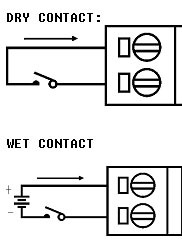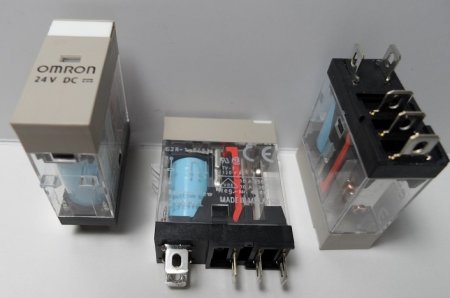What is a dry contact
A contact that is not galvanically connected to the supply circuit and ground at the moment is called a «dry contact». A desktop calculator button, push-to-talk microphone switch, and reed switch contacts are excellent examples of dry contacts. And, say, the contact of the switch that closes the phase wire earth-lamp circuit (220 volt network) is not a dry contact, because in a normal state it is always powered by the network, as it is galvanically connected to it.
The output contacts of an electromagnetic or optical relay are examples of dry contacts, while the control voltage itself is supplied to another circuit: the power supply of the electromagnetic relay is supplied to the coil of the relay, not to the contacts themselves, while the direct contacts of this relay may not carry responsibility at all for power supply. We can say that the «dry contact» is separated from the signal directly controlling its state.
If, say, we are talking about discrete inputs or outputs of an electronic device, then depending on the point of view of the signal sent or received on the wires, the input or output can have a dry or «wet» contact.
Let's take a crude example. Suppose a socket on one wall of a room is connected by means of a plug and a two-wire wire to a floor lamp which stands near the opposite wall.
Let's mentally break the connection right in the middle of the two-wire wire. Now let's stand with our backs to the outlet and look at the lamp with the wires attached to it. Obviously, the wires connected to the lamp have dry contacts, because there is no voltage on them, since they are not connected to phase or ground.
Now let's go to the lamp and look at the socket, from which, at first glance, the same wires as the lamp protrude. The contacts of these wires are obviously not dry, since mains voltage is applied to them, that is, the contacts are galvanically connected to the supply circuit.
A dry contact electronic device input is an input that is capable of responding to the open and closed states of the sensor contacts in the field and without any external power supply to the sensor. A closed or open state is the signal from such a sensor.

It is clear that in the absence of external power circuits, each executive contact is dry. In English-language literature, dry contact is called "Dry contact", and as the opposite of this term, the term "Wet contact" is used, if translated into Russian - "wet contact". In our country, this term somehow did not take root.Nevertheless, the operating voltage will be present at the «wet contact» in at least one of the positions.
The wet terminal needs an external power supply to get the operating voltage, as in the above example with a wall outlet and a floor lamp. As for a dry contact, in principle both its outputs are by definition at the same potential, that is, a dry contact is by definition a potential-free contact.
Dry contacts can be both normally closed and normally open, they are used in AC or DC circuits, depending on the tasks solved with their help. The application of dry contact is very diverse. Dry contact is particularly widely used in industrial and domestic automation systems, in security and fire alarm systems, in relay protection, etc.
Simplicity of design, low cost and wide compatibility are the main advantages of dry contact solutions. As for the disadvantages, they are limited electrical resistance, limited resource and low performance.

